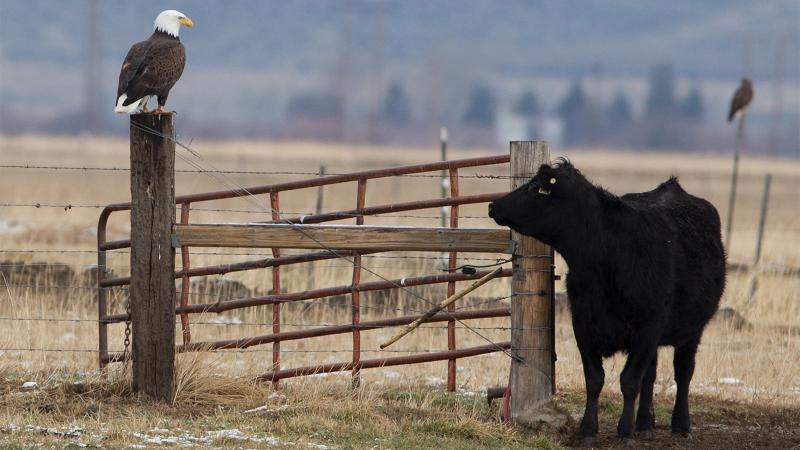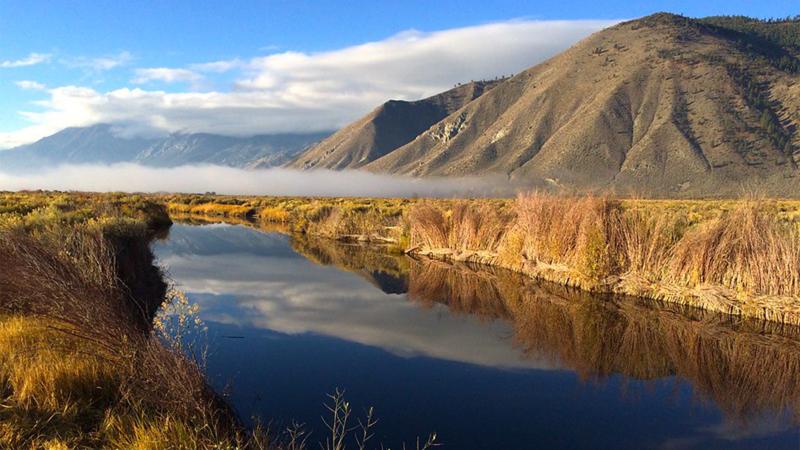Nevada’s Carson Valley, situated in the foothills of the eastern Sierra Nevada and Lake Tahoe, beckons visitors and wildlife to relish high desert landscapes. From wildlife watching to trekking through springtime blooms, here are six ways to celebrate all things wild in Carson Valley.
1. Enjoy the Wildlife
With one of the driest climates in America, nearly all of Nevada’s seven National Wildlife Refuges involve and conserve whatever water has remained in a landscape with no outlets to the ocean offering critical habitats for migratory birds who stop at the Great Basin to rest, refuel and sometimes settle in for the long haul. Birds following the Pacific Flyway flock to Carson Valley’s wetland meadows, flowing creeks, streams, reservoirs and irrigation canals year-round.
From Topaz Lake to Gardnerville, Minden and Genoa, this northwestern Nevada region attracts mule deer, black bears, jackrabbits, bobcats, eagles and hundreds of other bird species, besides bands of wild horses. The area is intermixed with wetland meadows and trails abundant with wildflowers and wildlife sightings.

2. Take a Photography Tour
Budding and professional photographers alike can experience Carson Valley’s high desert terrain with a tour from one of several local guides, who bring expertise and encourage photography as a form of engagement. The tours take visitors from the steps of hotels and motels, along a dirt road into the Pine Nut Mountains. From there, views of Jobs Peak and the surrounding Sierra Nevada make the perfect backdrop for bands of wild mustangs. All the guides encourage a wildlife-first approach focused on safety and respect.
Located minutes from Genoa, the first permanent settlement in the state, is 800 acres of lush meadows, wetland habitats, access to Carson River and picture-perfect views. Thanks to the preservation efforts of The Nature Conservancy and private landowners, wildlife conservation is first here.
3. Walk Through Protected Land
The River Fork Ranch is located at the confluence of the east and west forks of the Carson River, and through careful planning and conservation work, is at the heart of a network of ranch lands and pastures, wetlands and meadows that support a dynamic ecosystem of creatures including eagles, owls, monarch butterflies, sandhill cranes, mule deer, leopard frogs, pond turtles and more. Spring and summer are the wettest for the habitat; a network of walking trails offers information about the fragile ecosystems, park benches at scenic overlooks, and 360-degree valley and mountain views.

4. Enjoy an Alpine Lake
Unlike most other alpine lakes in the eastern Sierra which are typically frozen over in the winter and even late into spring, Topaz Lake’s trout-filled waters remain flowing and accessible year-round. Straddling the California-Nevada state line, Topaz Lake is 40 minutes south of Gardnerville on U.S. 395 in the high desert hills. The lake draws mule deer, desert bighorn sheep, jackrabbit, kit fox, osprey, pelican and more that rely upon its waters. Walking trails provide for hiking around the Topaz Lake Recreation Area’s tiny peninsula leading to scenic overlooks which are eye-catching during spring when wildflowers are in bloom.
5. Pack a Picnic
Situated within Minden at the junction of U.S. Highway 395 and Highway 88, Jake’s Wetland and Wildlife Meadow provide easy access and an ideal way to get outside, especially for families with small children. Paved pathways allow for easy access to nearly eight acres of natural wetlands brimming with resident and migrating birds, wildflower blooms and plenty of areas to discover.
Part of the Martin Slough, which funnels water from the Carson River through Gardnerville and Minden for ranching irrigation, water for hundreds of trees and shrubs, better water quality for area residents, and now a man-made lake supports Jake’s Wetland & Wildlife Meadow. Before hitting the trail, grab a sandwich and other treats and stretch out for a picnic lunch.

6. Hike Jack’s Valley Wildlife Management Area
Situated on the northern edge of Carson Valley along one of the region’s most wildlife-packed routes, discover hundreds of birds, mule deer and more at Jack’s Valley Wildlife Management Area. Made possible thanks to many land managers joining forces in the name of wildlife conservation, founding groups include the Nevada Land Trust, Conservation Fund, tribal landowners and United States Forestry Service (USFS) working together to protect over 3,000 acres of land from development along the Carson Front. Keep those binoculars and cameras handy for bird-watching the likes of black-billed magpie, western meadowlark, sage sparrow, brewer’s sparrow, sage thrasher, loggerhead shrike and more–all of whom seek refuge here.
The Clear Creek Trail System can also be accessed along Jack’s Valley Road and the Wildlife Management Area, which unites the Clear Creek Trail, Jacks Valley Loop, and Clear Creek Connector for Carson Valley’s longest multi-use trail system. Keep an eye out for mule deer, bobcats, jackrabbit and coyote, along with red-tailed hawks, golden eagles and other raptors riding the Carson Valley’s thermals.
For more information, go to www.visitcarsonvalley.org.
Related Stories
Regenerative Tourism Program Launched in Palm Springs, CA
Aspen Meadows Resort Unveils Guest Suite Renovation